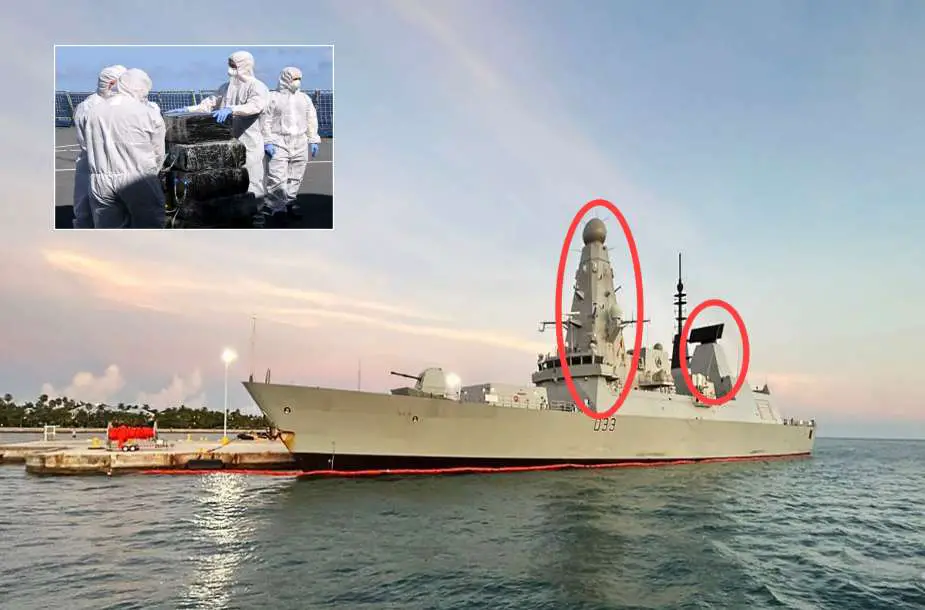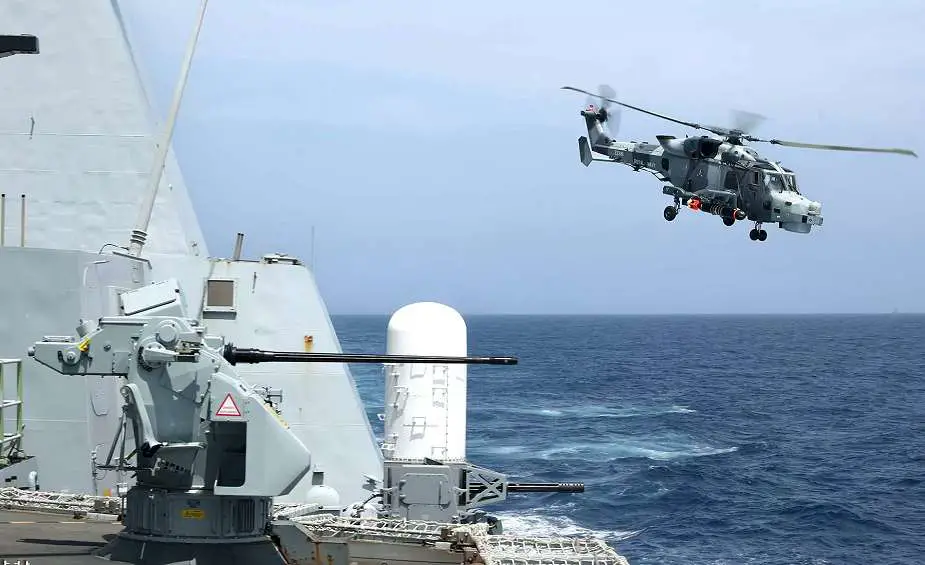Breaking news
HMS Dauntless seizes cocaine in the Caribbean using Sampson radar.
On September 9, the Royal Navy announced via its Twitter account that HMS Dauntless, a Type 45 destroyer, had carried out two operations in the Caribbean Sea, leading to the confiscation of over a tonne of cocaine. The Portsmouth-based warship collaborated closely with the US Coast Guard and Royal Marines for these operations. The ship's Sampson radar played a crucial role in both operations.
Follow Navy Recognition on Google News at this link
 HMS Dauntless, a Type 45 destroyer, had carried out two operations in the Caribbean Sea, leading to the confiscation of over a tonne of cocaine. The ship's Sampson radar, prominently visible at the center of the photo on HMS Dauntless, played a crucial role in both operations. The radar defense system also includes the S1850M long-range radars visible at the stern of the ship. (Picture source: British MoD)
HMS Dauntless, a Type 45 destroyer, had carried out two operations in the Caribbean Sea, leading to the confiscation of over a tonne of cocaine. The ship's Sampson radar, prominently visible at the center of the photo on HMS Dauntless, played a crucial role in both operations. The radar defense system also includes the S1850M long-range radars visible at the stern of the ship. (Picture source: British MoD)
HMS Dauntless is a Type 45 or Daring-class destroyer. The ship has a standard crew of 191 sailors and officers but can accommodate up to 285 personnel if needed. The ship's dimensions are 152.4 meters in length, a beam of 21.2 meters, and a draught of 7.4 meters. She has a total displacement of approximately 7,350 tonnes. The ship's armament includes up to 48 Aster 15 and Aster 30 missiles, a 114mm mk8 mod 1 gun, and two 30mm guns. Additionally, the ship has a flight deck and hangar to support the operations of a single helicopter, either a Lynx HMA8 or Merlin EH101 HAS 1.
HMS Dauntless is currently deployed in the Caribbean Sea for four months to intercept drug smugglers and disrupt illegal activities. Additionally, the ship provides support to British Overseas Territories during the hurricane season.
In the first operation, the ship's SAMPSON radar system alerted the crew to the presence of a suspect vessel. After verification, HMS Dauntless launched its Wildcat helicopter and deployed a Royal Marines and the US Coast Guard team. The operation led to the seizure of 1,230 kg of cocaine.
In a second operation, the ship assisted US law enforcement agencies in tracking a suspicious aircraft flying from Venezuela. Ground forces were alerted and seized an additional 550 kg of cocaine upon the aircraft's arrival.
The ship's radar capabilities played a significant role in these operations. The SAMPSON multifunction radar can detect air and surface targets up to a distance of 400 km and has the ability to track multiple targets simultaneously. This radar is part of the Sea Viper air-defense system, which also includes the S1850M long-range radars.
The SAMPSON multifunction radar system, originally derived from the MESAR program, has undergone various phases of development and ownership, starting with Plessey in 1982 and eventually becoming part of BAE Systems. Initially intended for the Horizon-class frigate, a collaborative project between the UK, France, and Italy, the radar was ultimately deployed on the UK's Type 45 destroyers due to complications in the original program. Manufactured in Cowes, Isle of Wight, the SAMPSON radar is paired with the PAAMS missile system and has demonstrated extended capabilities, such as detecting and tracking ballistic missiles, as evidenced by successful trials conducted with HMS Daring in 2013 near the US Army Kwajalein Atoll.
The SAMPSON radar system, deployed on the UK's Type 45 destroyers, is an active array radar that uses software-controlled beams for multifunctionality and resistance to jamming, offering advantages over conventional radars. Unlike systems like the US AN/SPY-1 and Dutch APAR, which provide continuous 360-degree coverage, SAMPSON uses two rotating planar arrays, ensuring no part of the sky lacks coverage for more than half a second. Its higher placement on the mast enhances its performance against low-level targets. However, the system has limitations in multitasking, such as long-range volume search, which led to the Royal Navy pairing it with the S1850M long-range radar to create a complementary system.
The S1850M long-range radar, manufactured by Thales and BAE Systems Integrated System Technologies, is a modified version of the Thales Nederland SMART-L radar. It features a digital antenna array and is capable of automatically detecting and tracking up to 1,000 targets at a range of 400 kilometers. The system is also designed to detect stealth targets and can track outer atmosphere objects, making it suitable for Theatre Ballistic Missile Defence.
Launched in January 2007 at Govan, HMS Dauntless is the British Royal Navy's second Type 45 or Daring-class air-defense destroyer. The ship was officially transferred to the Royal Navy on December 3, 2009, and underwent formal commissioning on June 3, 2010.

In the first operation, HMS Dauntless launched its Wildcat helicopter and deployed a Royal Marines and the US Coast Guard team. (Picture source: British MoD)


























